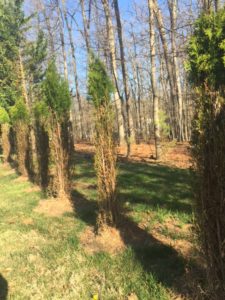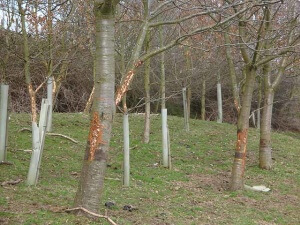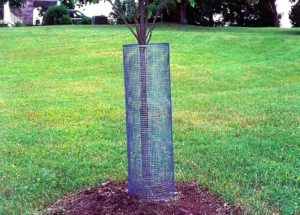Deer damage can be costly, unsightly, and even deadly to trees and shrubs. In some cases, this damage can have long term effects and disfigure your landscape. Annual estimates of deer damage are reported to exceed $250 million in damage to metropolitan households (e.g., landscape plantings). Read on to learn how deer damage trees and how to protect your landscape investments from deer.
How Do Deer Damage Trees?
There are two main ways deer damage trees: 1) feeding on foliage and 2) rutting.
Feeding On Foliage:

During the fall and winter food can be scarce for deer. When the food supply is low, deer will wander into your yards and gardens and feast on your plants, trees, and shrubs. Although deer browsing may not sound like that big of a deal the damage can be extensive. Deer feeding on foliage can affect the plant’s shape and ability to feed itself through photosynthesis.
Euonymus (also called spindle, burning-bush, strawberry-bush, wahoo, or wintercreeper) is a favorite target of deer. Hosta (Host sp.), Candy Lily (Pardancanda x norrisii), Roses, Yews (Taxus sp.) American Arborviate (Thuja occidentalis), Evergreen Azaleas & Rhododendron (Rhododendron sp) are also high on the favorite food list for deer. If you have any of these species you may see more instances of deer feeding in your yard.
Rutting:

During fall male deer are looking to clean their antlers of summer velvet, while at the same time marking territory during the breeding season. They achieve this by rubbing their antlers against trees to remove the velvet and by thrashing and battering the tree. When deer rub their antlers against the tree it removes the tree’s cambium.
Cambium is the layer between the bark and the wood that helps transport nutrients through the tree. When the tree’s cambium is severely damaged the tree is at risk of dying. Young trees, especially those 1 to 4 inches in diameter with smooth bark, such as maple, magnolias, and birch, are especially susceptible to rutting. Because this is also a territorial action, the buck may revisit trees they like in subsequent years.
Need Help With Preventing Deer Damage?
Or Give Us A Call At 703-573-3029
How To Stop Deer From Feeding On Trees

The trick to keeping deer from eating your shrubs is to make these usually tasty feasts taste terrible. We do this by treating the shrub’s foliage with a special product that makes your shrubs taste bad. The next time the deer wander onto your property for a snack, they will go in for a taste but quickly find out that what looks like their favorite meal tastes horrible. Discouraged they will move on to the next tasty plant in the vicinity (usually your neighbor’s plants unless they get deer protection as well.)
This treatment is safe and not harmful to your plants/shrubs. However, it is not advised for Blue spruces otherwise their blue tint will be removed. To learn more, schedule an appointment with one of our Certified Arborists by calling 703-573-3029 or booking through our online scheduler.
How To Stop Deer From Rutting

The easiest way to stop deer from rubbing their antlers on your tree is to put up a physical barrier. You can accomplish a physical barrier in a few ways. One of the most expensive and involved ways is to put up protective fencing around your yard. This would mean a fence that is 6 feet tall that deer can not jump over or get through. However, this isn’t feasible or realistic for many homeowners and luckily there are cheaper and easier options.
The easiest option is for homeowners to purchase wire or plastic tree guards that wrap around the base of the tree. You can also make your own tree guards by using chicken wire just make sure the wire is taller than your average buck. SF Gate suggests the height of tree guards should be 4-5 feet tall for full protection.
Fixing Deer Damage That Has Already Occurred:
If you already have deer damage on your tree it can not be reversed. However, if you properly maintain your tree and give it a little TLC the tree may be able to recover, depending on the extent of the damage. Our Arborists suggest utilizing mulching, bio-stimulants, preventative disease/insect treatments, proper watering, aeration, and regular pruning to help your tree recover from deer damage.
If you need help preventing deer damage or helping your tree recover from deer damage we can help. Give us a call at 703-573-3029 or book an appointment with one of our Certified Arborists through our online scheduler.
